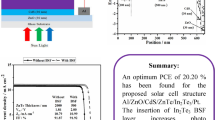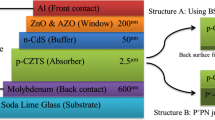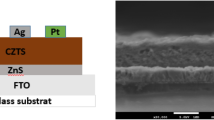Abstract
In order to improve photovoltaic performance of solar cells based on ZnTe thin films two device structures have been proposed and its photovoltaic parameters have been numerically simulated using Solar Cell Capacitance Simulator software. The first one is the ZnO/CdS/ZnTe conventional structure and the second one is the ZnO/CdS/ZnTe/P+-ZnTe structure with a P+-ZnTe layer inserted at the back surface of ZnTe active layer to produce a back surface field effect which could reduce back carrier recombination and thus increase the photovoltaic conversion efficiency of cells. The effect of ZnO, CdS and ZnTe layer thicknesses and the P+-ZnTe added layer and its thickness have been optimized for producing maximum working parameters such as: open-circuit voltage Voc, short-circuit current density Jsc, fill factor FF, photovoltaic conversion efficiency η. The solar cell with ZnTe/P+-ZnTe junction showed remarkably higher conversion efficiency over the conventional solar cell based on ZnTe layer and the conversion efficiency of the ZnO/CdS/ZnTe/P+-ZnTe solar cell was found to be dependent on ZnTe and P+-ZnTe layer thicknesses. The optimization of ZnTe, CdS and ZnTe layers and the inserting of P+-ZnTe back surface layer results in an enhancement of the energy conversion efficiency since its maximum has increased from 10% for ZnO, CdS and ZnTe layer thicknesses of 0.05, 0.08 and 2 µm, respectively to 13.37% when ZnO, CdS, ZnTe and P+-ZnTe layer thicknesses are closed to 0.03, 0.03, 0.5 and 0.1 µm, respectively. Furthermore, the highest calculated output parameters have been Jsc = 9.35 mA/cm2, Voc = 1.81 V, η = 13.37% and FF = 79.05% achieved with ZnO, CdS, ZnTe, and P+-ZnTe layer thicknesses about 0.03, 0.03, 0.5 and 0.1 µm, respectively. Finally, the spectral response in the long-wavelength region for ZnO/CdS/ZnTe solar cells has decreased at the increase of back surface recombination velocity. However, it has exhibited a red shift and showed no dependence of back surface recombination velocity for ZnO/CdS/ZnTe/P + -ZnTe solar cells.










Similar content being viewed by others
References
Amin, N., Isaka, T., Okamoto, T., Yamada, A., Konagai, M.: Prospects of thickness reduction of the CdTe layer in highly efficient CdTe solar cells towards 1 µm. Jpn. J. Appl. Phys. 38(8), 4666–4672 (1999)
Amin, N., Isaka, T., Yamada, A., Konagai, M.: Highly efficient 1 μm thick CdTe solar cells with textured TCOs. Sol. Energy Mater. Sol. Cells 67, 195–201 (2001)
Britt, J., Ferekides, C.: Thin-film CdS/CdTe solar cell with 15.8% efficiency. Appl. Phys. Lett. 62, 2851–2852 (1993)
Dow, J.D., Hong, R.-D., Klemm, S., Ren, S.Y., Tsai, M.-H., Sankey, O.F., Kasowski, R.V.: Proposed explanation of the p-type doping proclivity of ZnTe. Phys. Rev. B (Condens. Matter) 43, 4396–4407 (1991)
Durbin, S.M., Gray, J.L.: Numerical modeling of photon recycling in high efficiency GaAs solar cells. Proc. IEEE 0181–0191 (1991)
Fan, Z., Lu, J.G.: Zinc oxide nanostructures: synthesis and properties. J. Nanosci. Nanotechnol. 5(10), 1561–1573 (2005)
Fonash, S.: Solar Cell Device Physics, 2nd edn. Elsevier, Amsterdam (2012)
Kaneta, A., Adachi, S.: Photoreflectance study in the E1 and E1 + 1 transition regions of ZnTe. J. Phys. D Appl. Phys. 33, 901–905 (2000)
Mandel, G.: Self-compensation limited conductivity in binary semiconductors. Phys. Rev. 134, A1073–A1079 (1964)
Niemegeers, A., Burgelman, M., Decock, K.: SCAPS Manual. University of Gent, Ghent (2014)
Pawlikowski, J.M.: Comments on the determination of the absorption coefficient of thin semiconductor films. Thin Solid Films 127(1), 29–38 (1985)
Pistone, A., Arico, A.S., Antonucci, P.L., Silvestro, D., Antonucci, V.: Preparation and characterization of thin film ZnCuTe semiconductors. Sol. Energy Mater. Sol. Cells 53, 255–267 (1998)
Schwartz, R.J., Turner, G.B.: Numerical cell performance modeling and predictions for the future. Proc. IEEE 0019–0023 (1987)
Shockley, W., Read, W.T.: Statistics of the recombinations of holes and electrons. Phys. Rev. 87, 835–842 (1952)
Skhouni, O., El Manouni, A., Mollar, M., Schrebler, R., Marí, B.: ZnTe thin films grown by electrodeposition technique on fluorine tin oxide substrates. Thin Solid Films 564, 195–200 (2014)
Skhouni, O., El Manouni, A., Marí, B.: Numerical study of the influence of ZnTe thickness on CdS/ZnTe solar cell performance. Eur. Phys. J. Appl. Phys. 74(2), 24602 (2016). https://doi.org/10.1051/epjap/2015150365
Soykan, C., Ozdemir Kart, S., Cagın, T.: Structural and mechanical properties of ZnTe in the zincblende phase. Arch. Mater. Sci. Eng. 46(2), 115–119 (2010)
Verity, D., Bryant, F.J., Scott, C.G., Shaw, D.: Deep level transient spectroscopy of hole traps in Zn-annealed ZnTe. Solid State Commun. 46(11), 795–798 (1983)
Acknowledgements
This work was supported by Ministerio de Economía y Competitividad (ENE2016-77798-C4-2-R) and Generalitat valenciana (Prometeus 2014/044).
Author information
Authors and Affiliations
Corresponding author
Rights and permissions
About this article
Cite this article
Bayad, H., El Manouni, A., Marí, B. et al. Influence of P+-ZnTe back surface contact on photovoltaic performance of ZnTe based solar cells. Opt Quant Electron 50, 259 (2018). https://doi.org/10.1007/s11082-018-1530-0
Received:
Accepted:
Published:
DOI: https://doi.org/10.1007/s11082-018-1530-0




